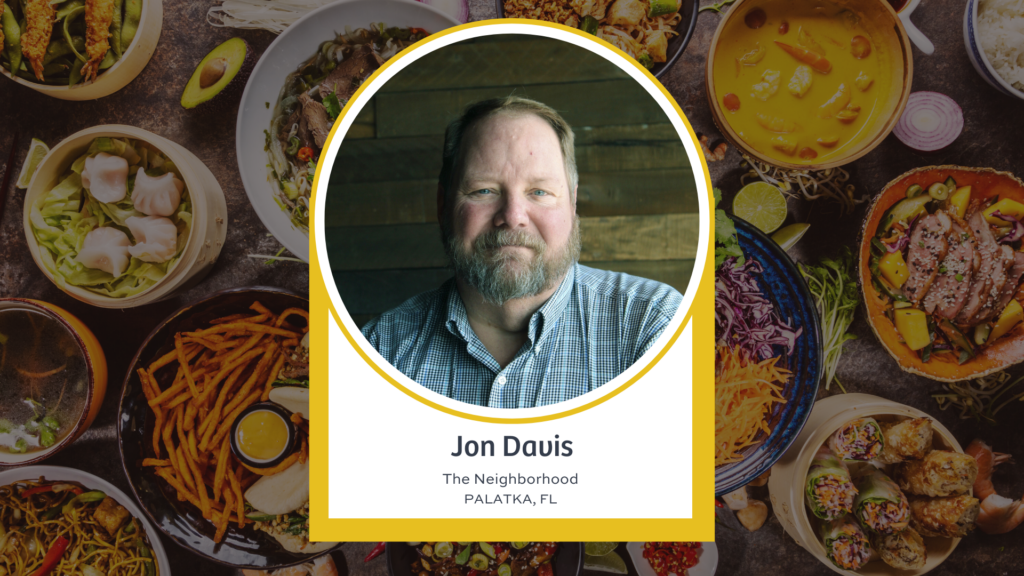Listen
Watch
Show Notes
The deepest dive into the theology and history of the Dinner Church is DCSL, which is a graduate program. In this episode Jon & Verlon discuss the remarkably large opportunity for the body of Christ in the West that is afforded by embracing the Dinner Church movement and its predictable effectiveness with the secular population. They conclude by offering some compelling reasons to give one evening/week for nine months taking this historic ecclesial dive.
The Rev. Canon Jon Davis, PhD. coordinates major Fresh Expression events, training and resources for the Dinner Church Collective and is a mission strategist and trainer on the Fresh Expressions team. He is an Episcopal priest serving as the part-time Rector of historic St. Mark’s Episcopal Church in Palatka, Florida. Jon is an affiliate professor with Kairos University. He has expertise in youth ministry, worship and liturgy (PhD focus), church growth and planting, missions and more. He is an engaging speaker, writer, worship leader and ministry trainer. He and his wife Beth live on a little farm in Oviedo, Florida.
Help us spread the word about the Dinner Church podcast by subscribing and leaving us reviews on Apple Podcasts, Spotify, YouTube or wherever you enjoy your podcasts.

Related Resources:
Dinner Church School of Leadership
Email us: podcasts@freshexpressions.com
Interview Summary
“In a most beautiful way, dinner churches are not an innovation. They are a recovery project of an ancient form of church,” explains Verlon Fosner, the director of the Dinner Church Collective and pastor of a historic church in Seattle.
Dinner churches bridge the gap between church and secular world, offering a non-threatening space where people can explore faith.
Historical Roots and Contemporary Relevance
The dinner church model is inspired by the earliest forms of Christian gatherings, which often took place in homes and centered around shared meals. These early Christian meetings were integral to the communal and spiritual lives of the followers, emphasizing fellowship and the breaking of bread as key elements of worship. This model is reflective of Jesus’ own practices, as many of His teachings and interactions occurred over meals.
In today’s context, where traditional church attendance has declined and skepticism towards organized religion has increased, the dinner church model offers a more relaxed, welcoming, and intimate setting.
The dinner church model offers a relaxed, welcoming, and intimate setting that attracts individuals who might feel alienated by more formal religious settings.
Practical Implementations and Challenges
Practical Implementations:
- Location Versatility: Dinner churches can be set up in various locations, from urban centers to rural communities, adapting to the local culture and needs.
- Simple and Low-Cost Setup: The model does not require elaborate infrastructure. A simple setup with tables, food, and a welcoming atmosphere suffices, making it economically feasible.
- Community Engagement: These gatherings are community-driven, focusing on local involvement and leadership. They serve not only spiritual needs but also social and communal ones, fostering a strong sense of belonging.
Challenges:
- Sustainability: Maintaining the enthusiasm and operational logistics as the dinner church grows can be challenging, especially when scaling across different neighborhoods or cities.
- Diverse Needs: Adapting to the varied demographic and cultural backgrounds of attendees requires flexible and innovative approaches to worship and community building.
- Training Leaders: Ensuring that leaders are equipped to handle the unique dynamics of dinner church, including pastoral care in a less formal setting, is crucial for effective ministry.
Impactful Stories and Outcomes
These turnarounds stories, many of them were pastoring churches that were in decline. Like what ours was. and yet as they opened up their dinner, church congregation, they found the path to the front lines of the gospel.
Verlon Fosner
The dinner church movement has revitalized community engagement and individual lives through its inclusive approach, particularly in areas where traditional churches were declining. By creating welcoming spaces for open dialogue and shared meals, these churches attract a diverse crowd, including those previously disengaged from religious practices. Many attendees have found a renewed sense of purpose and belonging, experiencing significant personal transformations. These gatherings not only foster community spirit but also contribute to local development efforts, extending their impact beyond spiritual growth. The model’s scalability and adaptability have facilitated its replication across different cultural and geographic contexts, demonstrating its continued relevance and effectiveness in today’s society.
The dinner church model has demonstrated its profound effectiveness as a modern reimagining of ancient Christian practices, offering a warm and inclusive environment that re-engages the disenchanted and fosters deep communal ties. Through its unique approach of combining meals with ministry, it bridges the gap between the secular and the sacred, inviting individuals from all walks of life into meaningful conversations and connections. As dinner churches continue to spread, they promise not only to revitalize individual faith journeys but also to strengthen community bonds and address social needs, ensuring their relevance and sustainability in the ever-evolving landscape of faith-based community engagement.
Reflection Questions
- What aspects of the traditional church model do you find ineffective in today’s society, and how could the dinner church model address these issues?
- How can churches become more inclusive and engaging for people who feel isolated or disconnected from traditional church settings?
- How does the concept of a dinner church align with the scriptural practices of early Christianity?
- What are the potential impacts of dinner churches on long-term community development?
- Reflect on a time when a simple meal shared with others led to a deeper conversation or connection.

